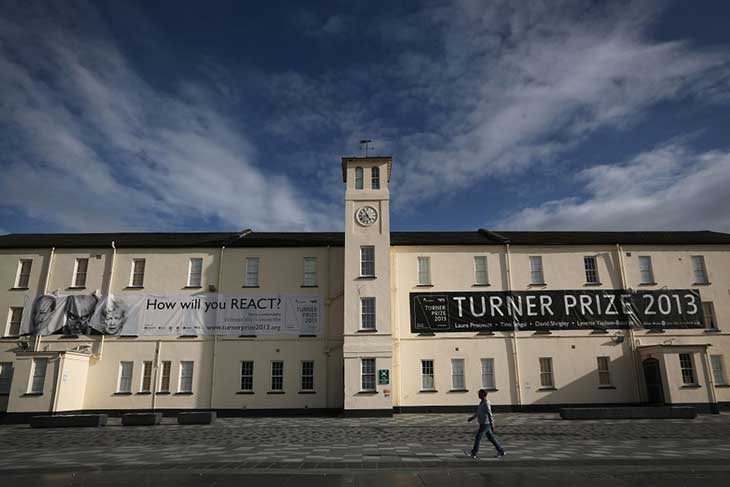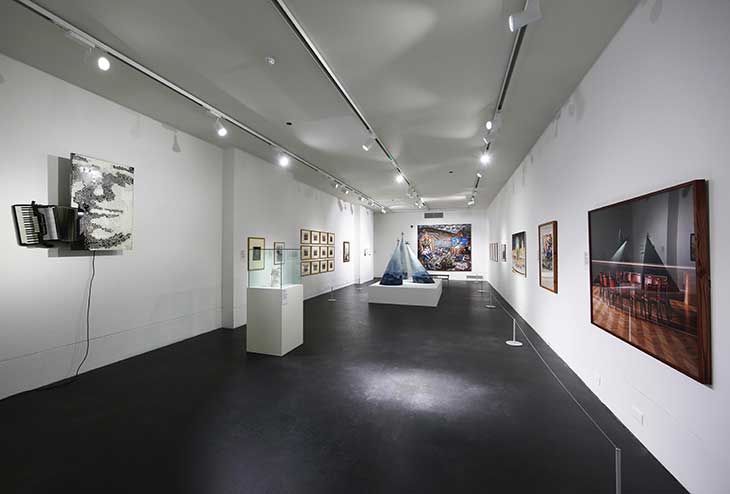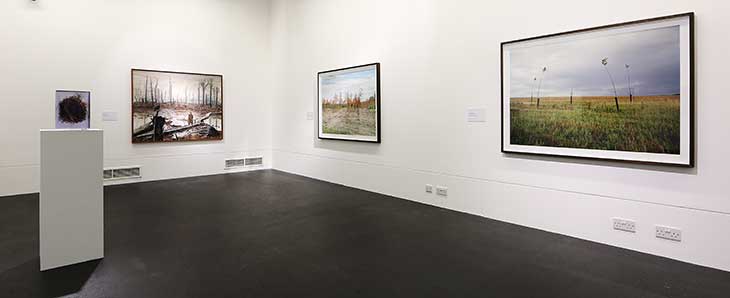Last month, out of the blue, the Nerve Visual Gallery in Building Eighty81, Ebrington, Derry announced that was closing, its last exhibition being ‘once a day every day all day long’ by the Derry-born artist Locky Morris.
The Ebrington site, which occupies 26 acres on the east bank of the River Foyle, was once a heavily-guarded barracks for the British Army, given as a gift to the people following the Good Friday Agreement. In 2011 the Peace Bridge, a footbridge connecting the two sides of Derry, running from Ebrington to the Cityside and its historic walls, was opened. Regeneration began, with the former military buildings spruced up and adapted for more progressive use, to the point where the Northern Ireland Executive’s website yourebrington.com now declares it to have been ‘established as regional destination at the heart of Derry-Londonderry’.
It isn’t, though – or not really. It’s a thoroughfare, albeit a very stylish one, an access route to and from the city centre for commuters who don’t want to pay car park charges and people who just fancy a bit of exercise. Despite talk of hotels, breweries, and museums, there is – now that Nerve Visual is closed – only a café and a gastropub. Such is the level of expectation in the city that news of the gallery’s closure was received with a sardonic chuckle and a ‘well, what do you expect?’

Ebrington Square, then the venue of the Turner Prize, in 2013. Photo: Dan Kitwood/Getty Images
It wasn’t always the case. In 2013, Derry was the UK’s City of Culture, and Building Eighty81 hosted the Turner Prize. Works by David Shrigley, Tino Sehgal, Lynette Yiadom-Boakye, and Laure Prouvost, the eventual winner, drew crowds to Ebrington, with many happily willing to queue for a chance to see what was on offer. There was a palpable sense of excitement in the rooms and a real pride that such an illustrious event was being held in the city.
When the Turner Prize headed back across the Irish Sea, there was plenty of talk – and not a little bickering – about what would happen next, with promises of a lasting link being established with the Tate to create a permanent gallery on the site. The talk soon stopped, although the bickering continued for a while longer, and for two years all the rooms were as empty as the space occupied by the performers of Tino Sehgal’s nominated work.
In June 2016, Building Eighty81 was rented by the Nerve Centre, a creative media arts centre based within the walls on the Cityside of Derry. For the next three years, Nerve Visual, as the gallery was called, put on 13 exhibitions of work by artists from Ireland and beyond. Crucially, there was never any core funding. The Nerve Centre had a number of projects in mind, and money had to be sought on a project-by-project basis. The cocktail of funders and partners included the Heritage Lottery Fund, the Irish Department of Foreign Affairs and Trade, the EU’s PEACE IV Programme, and National Museums NI.
As there was no core funding body, Nerve Visual had no remit to follow. That meant that, once the list of intended projects was exhausted, the gallery’s stay at Eighty81 came to a natural conclusion. It also meant that curators and organisers had a certain amount of freedom to explore their own interests and instincts, and those involved can look back with pride on a body of work of great power, beauty, and significance, not to mention a certain amount of playfulness as well as relevance. Almost all of the exhibitions were rooted, to some extent or other, in the experiences of the people of Derry and beyond, in the city itself, in the history of the island of Ireland. But that didn’t exclude, because the subjects they covered could be easily embraced by those from elsewhere.
One of the most memorable exhibitions was ‘Silent Testimony’, a series of portraits by Colin Davidson depicting the blighted faces of those who suffered during the 30 years of the Troubles. Another was ‘Troubles Art’, made up of sculptures, paintings and installations by a range of artists drawing on their experience of the conflict. A pop-up exhibition by Joe Campbell looked at the same period, yet brought in a different perspective, one of a man who saw soldiers spilling out of armoured cars on to the streets of his city, who saw the aftermath of bombings and shootings, but who also saw Laurel and Hardy and John Wayne films and the first moon landing on TV. Campbell crams these conflicting memories on to his canvases and murals with no attempt to reconcile or unify them.

Installation view of ‘Troubles Art’ at Nerve Visual Gallery, Derry, in 2019. Photo: Lorcan Doherty
An exhibition of work drawn from the life and death of Francis Ledwidge, a poet who joined up in the First World War and marched on the Ebrington parade ground and died in France, was full of tenderness, of love of home and nature – the sights and sounds of the land. For the exhibition ‘Film/Makers’ contemporary craftspeople were asked to look back at the makers of the past and respond to what they saw, producing a show of rich textures, modest colours, and natural materials. Craft was similarly explored in a show of 19 artist-makers from across Europe, exposed to the new technologies available at FabLabs in Derry, Madrid, and Limerick, and then let loose to produce using their new skills. The show was filled with playful surprises such as a 3D model of Michael Collins’s nose, as well as a glimpse into a forgotten moment in history when, in 1933, the Italian fascist Italo Balbo brought an armada of flying boats to Derry.
A shame, then, that more people didn’t get to visit the gallery. Although the Nerve Centre were happy with visitor numbers, I must confess that every time I went there, I was the only person present. The marketing budgets were tight, making it hard to spread the word, and leading to many people confessing, on hearing of the gallery’s closure, that they didn’t know it was there.

Installation view of ‘A Name Unmade: Francis Ledwidge (1887–1917)’ at Nerve Visual Gallery, Derry, in 2017. Photo: Lorcan Doherty
It will be a loss to Derry, and the wider north-west of Ireland. The demise of Nerve Visual leaves the Centre for Contemporary Arts and Void as the city’s main galleries, but, while both are admirable, they feature mainly highly conceptual contemporary art, of the sort that many find inaccessible or unappealing. The region is, however, teeming with artists, many of whom have banded together to form groups such as the non-profit Creative Village Arts, which focuses on artist development, and even create their own galleries, such as Art Link at Fort Dunree and the Wild Tulips Gallery in Derry.
Funding is a constant issue. There is a feeling in Derry that too much money goes towards too few galleries, and that the Arts Council in Northern Ireland regards the CCA and Void as the only serious shows in town. The story is slightly different in Donegal, although groups there still have to fight long and hard for money from Dublin.
I review art exhibitions for BBC radio in Northern Ireland, and also for the Culture NI website, and both BBC Radio Foyle and the Derry News rang to find out what I thought about the closure of Nerve Visual. I was in Liverpool at the time, a tourist in the city of my birth. The day before I, along with many others, had visited the Tate, a flagship occupant of the once derelict Albert Dock. The day after, again with many others, I went to the municipal Walker Art Gallery. Derry has neither a Tate, or anything approximating it, or a municipal gallery of any sort. Yet Derry is the second largest city in Northern Ireland and the fourth largest on the whole island. The nearest it has come to a regional gallery of any sort was the London Street Gallery. Despite attracting large numbers of visitors, that went when the City of Culture year came to an end. And now Nerve Visual has gone, too. The city and the region deserve more.

The closure of Nerve Visual in Derry is a real loss for the region
Courtesy Nerve Centre
Share
Last month, out of the blue, the Nerve Visual Gallery in Building Eighty81, Ebrington, Derry announced that was closing, its last exhibition being ‘once a day every day all day long’ by the Derry-born artist Locky Morris.
The Ebrington site, which occupies 26 acres on the east bank of the River Foyle, was once a heavily-guarded barracks for the British Army, given as a gift to the people following the Good Friday Agreement. In 2011 the Peace Bridge, a footbridge connecting the two sides of Derry, running from Ebrington to the Cityside and its historic walls, was opened. Regeneration began, with the former military buildings spruced up and adapted for more progressive use, to the point where the Northern Ireland Executive’s website yourebrington.com now declares it to have been ‘established as regional destination at the heart of Derry-Londonderry’.
It isn’t, though – or not really. It’s a thoroughfare, albeit a very stylish one, an access route to and from the city centre for commuters who don’t want to pay car park charges and people who just fancy a bit of exercise. Despite talk of hotels, breweries, and museums, there is – now that Nerve Visual is closed – only a café and a gastropub. Such is the level of expectation in the city that news of the gallery’s closure was received with a sardonic chuckle and a ‘well, what do you expect?’
Ebrington Square, then the venue of the Turner Prize, in 2013. Photo: Dan Kitwood/Getty Images
It wasn’t always the case. In 2013, Derry was the UK’s City of Culture, and Building Eighty81 hosted the Turner Prize. Works by David Shrigley, Tino Sehgal, Lynette Yiadom-Boakye, and Laure Prouvost, the eventual winner, drew crowds to Ebrington, with many happily willing to queue for a chance to see what was on offer. There was a palpable sense of excitement in the rooms and a real pride that such an illustrious event was being held in the city.
When the Turner Prize headed back across the Irish Sea, there was plenty of talk – and not a little bickering – about what would happen next, with promises of a lasting link being established with the Tate to create a permanent gallery on the site. The talk soon stopped, although the bickering continued for a while longer, and for two years all the rooms were as empty as the space occupied by the performers of Tino Sehgal’s nominated work.
In June 2016, Building Eighty81 was rented by the Nerve Centre, a creative media arts centre based within the walls on the Cityside of Derry. For the next three years, Nerve Visual, as the gallery was called, put on 13 exhibitions of work by artists from Ireland and beyond. Crucially, there was never any core funding. The Nerve Centre had a number of projects in mind, and money had to be sought on a project-by-project basis. The cocktail of funders and partners included the Heritage Lottery Fund, the Irish Department of Foreign Affairs and Trade, the EU’s PEACE IV Programme, and National Museums NI.
As there was no core funding body, Nerve Visual had no remit to follow. That meant that, once the list of intended projects was exhausted, the gallery’s stay at Eighty81 came to a natural conclusion. It also meant that curators and organisers had a certain amount of freedom to explore their own interests and instincts, and those involved can look back with pride on a body of work of great power, beauty, and significance, not to mention a certain amount of playfulness as well as relevance. Almost all of the exhibitions were rooted, to some extent or other, in the experiences of the people of Derry and beyond, in the city itself, in the history of the island of Ireland. But that didn’t exclude, because the subjects they covered could be easily embraced by those from elsewhere.
One of the most memorable exhibitions was ‘Silent Testimony’, a series of portraits by Colin Davidson depicting the blighted faces of those who suffered during the 30 years of the Troubles. Another was ‘Troubles Art’, made up of sculptures, paintings and installations by a range of artists drawing on their experience of the conflict. A pop-up exhibition by Joe Campbell looked at the same period, yet brought in a different perspective, one of a man who saw soldiers spilling out of armoured cars on to the streets of his city, who saw the aftermath of bombings and shootings, but who also saw Laurel and Hardy and John Wayne films and the first moon landing on TV. Campbell crams these conflicting memories on to his canvases and murals with no attempt to reconcile or unify them.
Installation view of ‘Troubles Art’ at Nerve Visual Gallery, Derry, in 2019. Photo: Lorcan Doherty
An exhibition of work drawn from the life and death of Francis Ledwidge, a poet who joined up in the First World War and marched on the Ebrington parade ground and died in France, was full of tenderness, of love of home and nature – the sights and sounds of the land. For the exhibition ‘Film/Makers’ contemporary craftspeople were asked to look back at the makers of the past and respond to what they saw, producing a show of rich textures, modest colours, and natural materials. Craft was similarly explored in a show of 19 artist-makers from across Europe, exposed to the new technologies available at FabLabs in Derry, Madrid, and Limerick, and then let loose to produce using their new skills. The show was filled with playful surprises such as a 3D model of Michael Collins’s nose, as well as a glimpse into a forgotten moment in history when, in 1933, the Italian fascist Italo Balbo brought an armada of flying boats to Derry.
A shame, then, that more people didn’t get to visit the gallery. Although the Nerve Centre were happy with visitor numbers, I must confess that every time I went there, I was the only person present. The marketing budgets were tight, making it hard to spread the word, and leading to many people confessing, on hearing of the gallery’s closure, that they didn’t know it was there.
Installation view of ‘A Name Unmade: Francis Ledwidge (1887–1917)’ at Nerve Visual Gallery, Derry, in 2017. Photo: Lorcan Doherty
It will be a loss to Derry, and the wider north-west of Ireland. The demise of Nerve Visual leaves the Centre for Contemporary Arts and Void as the city’s main galleries, but, while both are admirable, they feature mainly highly conceptual contemporary art, of the sort that many find inaccessible or unappealing. The region is, however, teeming with artists, many of whom have banded together to form groups such as the non-profit Creative Village Arts, which focuses on artist development, and even create their own galleries, such as Art Link at Fort Dunree and the Wild Tulips Gallery in Derry.
Funding is a constant issue. There is a feeling in Derry that too much money goes towards too few galleries, and that the Arts Council in Northern Ireland regards the CCA and Void as the only serious shows in town. The story is slightly different in Donegal, although groups there still have to fight long and hard for money from Dublin.
I review art exhibitions for BBC radio in Northern Ireland, and also for the Culture NI website, and both BBC Radio Foyle and the Derry News rang to find out what I thought about the closure of Nerve Visual. I was in Liverpool at the time, a tourist in the city of my birth. The day before I, along with many others, had visited the Tate, a flagship occupant of the once derelict Albert Dock. The day after, again with many others, I went to the municipal Walker Art Gallery. Derry has neither a Tate, or anything approximating it, or a municipal gallery of any sort. Yet Derry is the second largest city in Northern Ireland and the fourth largest on the whole island. The nearest it has come to a regional gallery of any sort was the London Street Gallery. Despite attracting large numbers of visitors, that went when the City of Culture year came to an end. And now Nerve Visual has gone, too. The city and the region deserve more.
Unlimited access from just $16 every 3 months
Subscribe to get unlimited and exclusive access to the top art stories, interviews and exhibition reviews.
Share
Recommended for you
What hope for civic museums?
In the last decade local authority funding for museums has declined rapidly – but are some reasons for optimism emerging?
In search of Seamus Heaney
A literary centre in the village of Bellaghy, County Derry returns visitors to the roots of Heaney’s poetry
The real threat to Northern Ireland’s museums
Funding cuts are a danger, but it’s the more insidious changes to the structure and attitude of public sector that we should really worry about